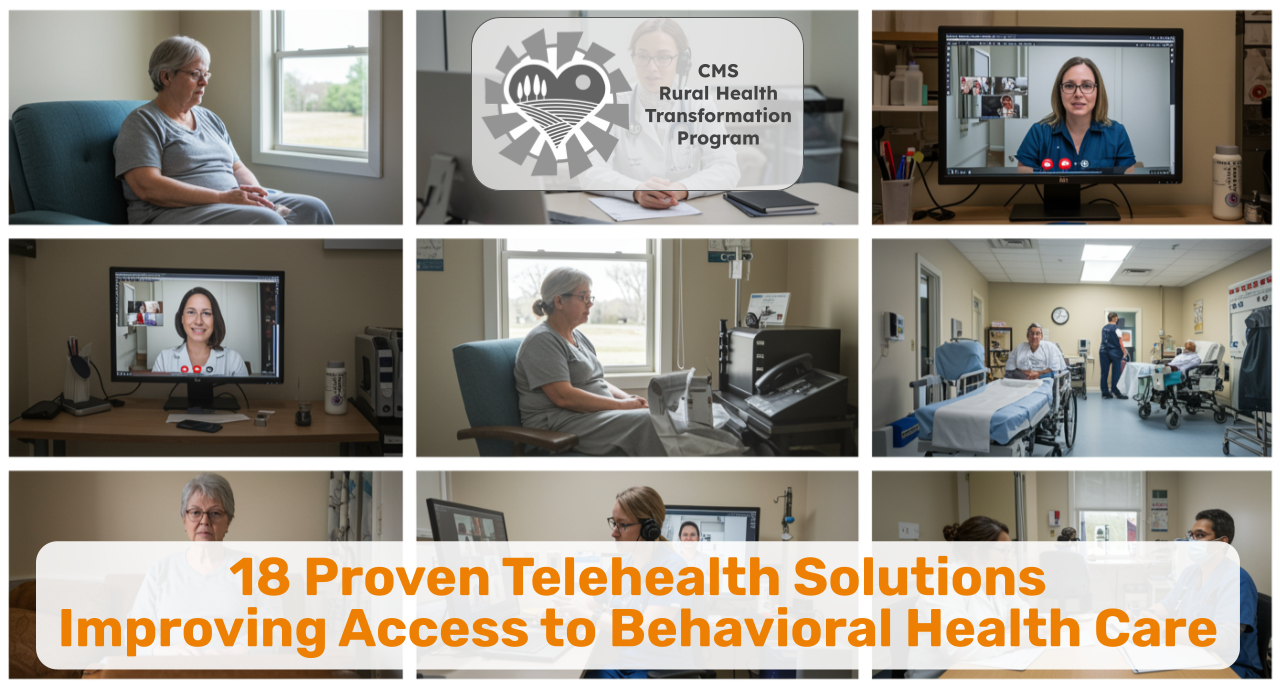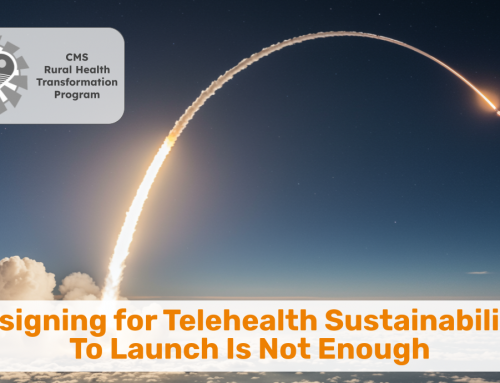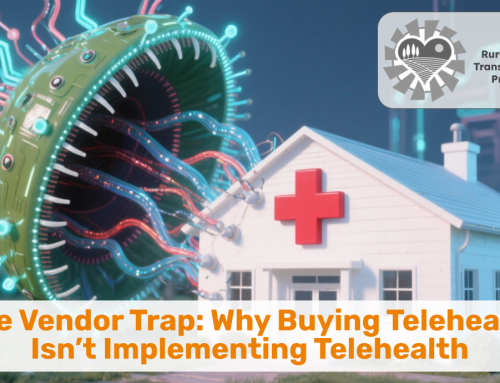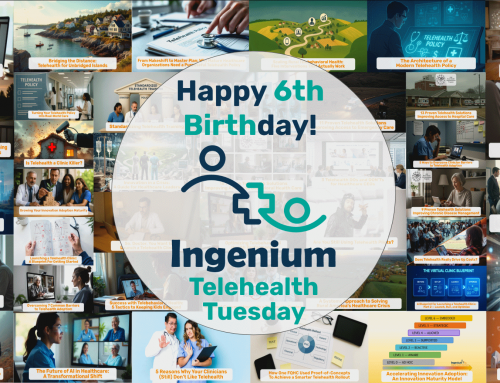Behavioral health remains one of the most pressing and underserved areas in healthcare — especially in rural and low-resource settings. As part of the broader effort to support rural innovation under CMS’s Rural Health Transformation (RHT) Program, this five-part series explores how telehealth can close access gaps across the care continuum.
After examining telehealth’s use to improve access to hospital care, emergency care, primary care, and chronic disease care, this final article turns to behavioral health — highlighting 18 proven telehealth solutions that help organizations deliver timely, effective, and equitable behavioral care.
CMS’s RHT Program places significant emphasis on expanding access to behavioral health through integrated care models, digital tools, and value-based payment arrangements. From digital therapeutics for substance use disorders to hub-and-spoke models that coordinate behavioral and physical health services, RHT recognizes telehealth as a key enabler of improved behavioral health outcomes in rural settings.
The 18 solutions below are organized into five strategic categories:
-
Synchronous Clinical Services: Live, scheduled telehealth visits delivered by licensed clinicians.
-
Platform & Network-Based Models: Scalable delivery models using centralized or third-party resources.
-
Digital Tools & Remote Monitoring: Technology-enabled support between visits to guide care and monitor risk.
-
Integrated & Embedded Behavioral Health: Behavioral services woven into primary, specialty, and inpatient care.
-
Crisis, Equity & Safety-Net Telehealth: Solutions designed to serve high-risk or underserved populations.
Synchronous Clinical Services
These foundational telehealth services deliver real-time care from licensed clinicians, providing the most direct and widely adopted telehealth interventions for behavioral health needs.
1. TeleTherapy (Individual Counseling): The most common use of telehealth by far — licensed therapists delivering one-on-one counseling sessions over video, or phone.
Impact: Improves access, reduces stigma (due to increased privacy), and offers flexible scheduling for ongoing care.
2. TelePsychiatry for Medication Management: Psychiatrists provide diagnosis, medication initiation, and follow-up care virtually — extending psychiatric capacity across settings and expanding geographic reach. Many of our rural clients are using virtual-only subcontracted Psychiatric NPs to provide access to psychiatric care.
Impact: Reduces wait times, supports medication adherence, and fills gaps in rural psychiatric coverage.
3. TeleGroup Therapy and TeleIOP: Group-based behavioral services, including intensive outpatient programs, are adapted for virtual delivery. Some of our clients offer hybrid TeleIOP where clients can join remotely from home or the nearest clinic. Some of our clients are offering virtual only, even immersive environments.
Impact: Expands capacity, supports peer-based models, and sustains engagement in structured care plans.
4. TeleCrisis Support in Emergency Departments: Remote psychiatric consults support ED teams in real time during behavioral health crises. Used by almost all of our clients.
Impact: Improves timely access, reduces windshield time or driving in inclement weather or at night. Reduces ED boarding times and enhances triage, especially in facilities without onsite psych.
5. TeleBehavioral Health at the Inpatient Bedside: Hospitals connect patients with remote behavioral specialists during their stay to improve the clinical care management. This can establish a relationship that continues after discharge.
Impact: Ensures timely psychiatric and psychological care, supports discharge planning, increases client engagement in their care plan and improves whole-person care.
Platform & Network-Based Models
These scalable approaches use third-party networks or centralized hubs to expand behavioral health capacity across multiple sites or regions.
6. Outsourced TelePsychiatry Networks: Similar to #2 above, organizations contract with virtual psychiatry vendors to provide consults and follow-up care.
Impact: Addresses psychiatrist shortages and enables rapid coverage across multiple sites.
7. Virtual-Only TeleTherapy Providers: These are the consumer-facing platforms that offer remote therapy independent of local health systems for a fixed monthly fee with 24×7 chat access to therapist and, typically, weekly video sessions.
Impact: Increases access to care, but may not be affordable to some and bring about challenges of care continuity, especially without integration into primary care.
8. Hub-and-Spoke Behavioral Health Models: Centralized clinical teams provide virtual consults and support to rural or remote clinics.
Impact: Scales behavioral care while maintaining quality across multiple rural locations.
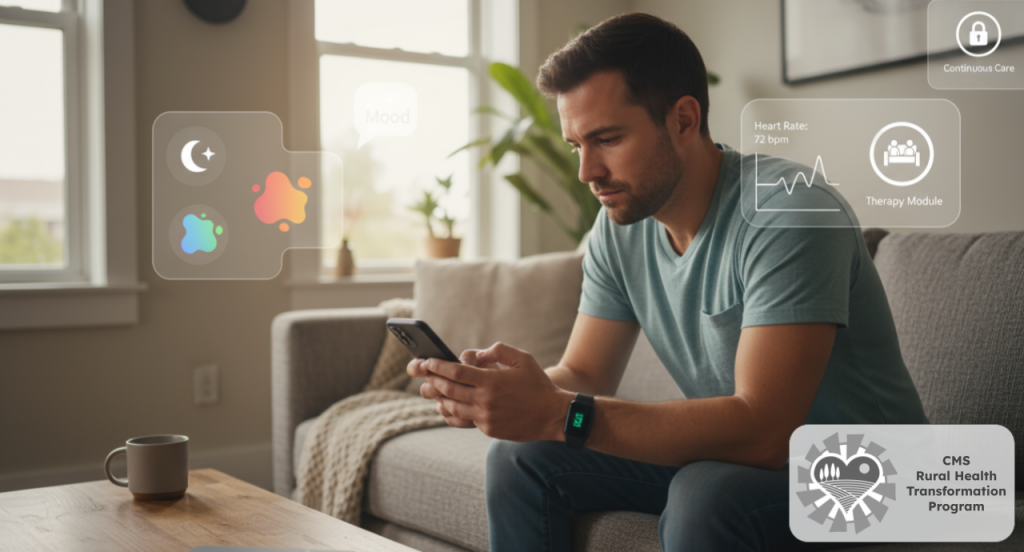


Digital Tools & Remote Monitoring
Now we are getting into the realm of more “fancier” technologies — digital therapeutics, mobile apps, and monitoring tools extend behavioral health care between visits, enabling continuous engagement, proactive outreach, and data-informed interventions.
9. Digital Therapeutics for Mental Health and SUDs: FDA-cleared apps deliver CBT-based or condition-specific behavioral interventions.
Impact: Augments therapy and fills gaps when clinicians or in-person care aren’t available.
10. Remote Physiological Monitoring (RPM) for Behavioral Health: Wearables, mobile apps, and connected devices that can track sleep, physical activity, and physiological indicators like heart rate variability can offer valuable behavioral insights between visits.
Impact: Enhances care continuity, supports early intervention, and supplies clinicians with objective, real-time behavioral data.
11. AI Chatbots and Digital Companions: Automated agents guide patients through structured check-ins or therapeutic content.
Impact: Enhances patient engagement and reduces isolation between clinical sessions.
12. Asynchronous Messaging and Check-Ins: Most of us use a form of texting to communicate with friends and family. The success of platforms such as those mentioned under #7 above proves that this is a preferred modality for patients: Secure communication platforms that support brief clinician-patient communication between visits.
Impact: Reinforces care plans, prevents drop-off, and supports flexible outreach.
Integrated & Embedded Behavioral Health
These solutions embed behavioral health directly into medical care environments, creating coordinated, team-based approaches to treat the whole person.
13. TeleBehavioral Health in Primary Care: Virtual consults support primary care teams via collaborative care models.
Impact: Improves screening, treatment adherence, and whole-person outcomes.
14. Behavioral Health Integration in Specialty Clinics: Oncology, cardiology, and other clinics embed virtual behavioral consults to assist patients in managing their diagnosis or chronic disease, enabling them to participate in their care plan.
Impact: Addresses psychosocial needs and improves chronic disease management.
15. Consult-Liaison TelePsychiatry in Hospitals: Medical teams collaborate with remote psychiatric providers during hospitalization.
Impact: Manages co-occurring conditions, supports discharge, and reduces readmissions.
16. Behavioral Telehealth in Nontraditional Settings: Telehealth brings care to schools, correctional facilities, and workplaces.
Impact: Extends behavioral services to underserved populations where care is rarely available.
Crisis, Equity & Safety-Net Telehealth
Focused on high-risk and underserved populations, these models use telehealth to close critical gaps in behavioral health access and responsiveness.
17. Mobile Crisis Teams with Telehealth Backup: Field-based crisis responders access virtual psych support in real time.
Impact: Strengthens crisis response in rural areas and improves assessment accuracy.
18. 24/7 Hotlines with TeleFollow-Up: Behavioral health hotlines pair with scheduled virtual visits post-crisis.
Impact: Improves continuity, reduces repeat ED visits, and supports recovery.
Conclusion: Behavioral Health Needs Strategy, Not Just Technology
As you can see by the sheer number of proven telehealth solutions, Telehealth is more than a workaround in behavioral health — it’s an essential strategy for closing access gaps and building more responsive, person-centered systems of care. But success depends on thoughtful implementation, cross-sector collaboration, and integration with local services.
Explore the RHTP and Scale What Works
Are you looking to improve access to behavioral health care and use proven telehealth strategies to do so? These solutions align with the direction CMS is advancing through its Rural Health Transformation Program — designed to support rural health systems in delivering high-quality, integrated care.
Even as the program evolves, now is the time to assess what works, strengthen your telehealth foundation, and prepare for what’s next.
Are you curious about one or more Telebehavioral Health services listed above? Then reach out to set up a call to discuss.








To receive articles like these in your Inbox every week, you can subscribe to Christian’s Telehealth Tuesday Newsletter.
Christian Milaster and his team optimize Telehealth Services for health systems and physician practices. Christian is the Founder and President of Ingenium Digital Health Advisors where he and his expert consortium partner with healthcare leaders to enable the delivery of extraordinary care.
Contact Christian by phone or text at 657-464-3648, via email, or video chat.

